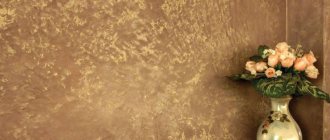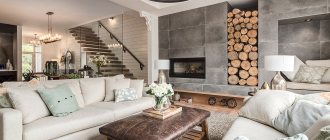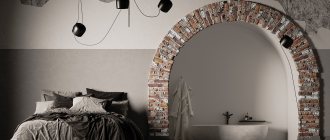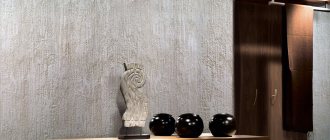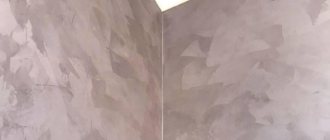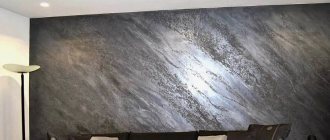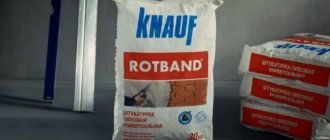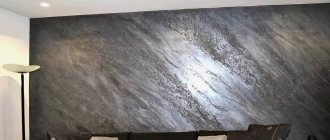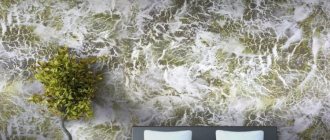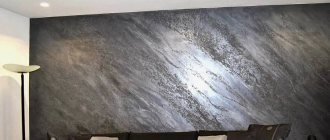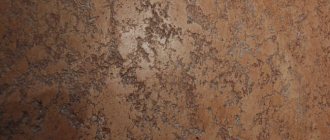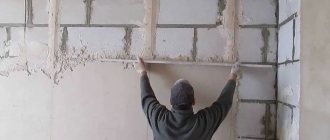Beton-House.com
Website about concrete: construction, characteristics, design. We combine the experience of professionals and private craftsmen in one place
Decorative plaster
Concrete walls are an ultra-fashionable and stylish solution for a modern interior. They came to us along with such styles as hi-tech and loft. Despite the monochrome and rough texture of the walls, they are able to make the interior warm and cozy. Concrete walls themselves require finishing to protect their porous, vapor-permeable surface.
Modern decorative concrete-like plaster comes to the rescue. Its use allows you to protect a concrete wall, as well as recreate the required texture on surfaces made of any materials. Therefore, stylish concrete walls in the interior have become available to everyone.
What is decorative plaster for concrete?
The secret of a good renovation is perfect walls. To decorate an apartment in the currently fashionable loft, grunge or military styles, decorative concrete-like plaster is ideal. These are special mixtures based on microcement or microconcrete. Using them, walls are finished quickly and efficiently, and different textures are reproduced. After renovation, the apartment looks creative and fashionable.
Concrete plaster
Decorative concrete plaster is used to decorate various rooms:
- commercial;
- industrial;
- residential
It successfully complements the interior and combines with:
- plank floors;
- glass windows;
- wooden furniture;
- brick partitions;
- iron decorative objects - lamps, chairs and others.
Important nuances that should be observed when constructing concrete walls
A number of features that you need to pay attention to when working with concrete walls:
- The formwork supports the entire perimeter of the walls.
- The height of one layer should not exceed 300 mm.
- Vibration is part of building foundation walls.
The formwork supports the entire perimeter of the walls.
Concrete walls will add a touch of originality to your home. The main thing is to decide in advance whether the walls will be made of natural material or the surfaces will be imitated. The costs of repairs and decoration depend on this.
Features and types of plaster
Dry, ready-made plastic mixtures for plastering are available in stores. They differ in composition, advantages, and disadvantages from conventional cement. They contain various additives and additives that improve properties. The mixtures also contain sand, small pebbles or stone chips to result in a rough, heterogeneous “playing” wall.
Manufacturers produce mixtures based on microcement or microconcrete.
| Base microcement | Micro concrete base | |
| Compound | Aqua cement, microfino, polymer additives, dye, no mineral chips | Cement, modifying additives, resins, dye, quartz chips |
| Application area | Interior, bathroom, toilets, furniture | External and internal works |
| Mix structure | Very thin, homogeneous | Porous |
| Properties | Resistance to salts and chlorine, high humidity | High plasticity, adhesion, hygroscopicity |
Advantages and disadvantages
Any material has advantages and disadvantages. The advantages of concrete compositions outweigh their disadvantages.
The material is lightweight, but at the same time durable. Any walls covered with these mixtures do not become heavier.
The coating is heat resistant. Applying concrete plaster is permissible on a metal, plastic or wooden base. The composition has good adhesion to the material it is coated with. Another advantage is the fact that decorative plaster for concrete does not absorb any foreign odors (even the strongest ones).
Classification of decorative plaster by types of fillers
Mixtures based on aquacement are highly resistant to moisture. Using them in rooms with constantly high humidity is an excellent solution to the problem. The advantages of plastered walls include resistance to mold, mechanical stress, and non-flammability.
The concrete composition is easy to apply and dries quickly. With its help you can create various patterns and decorative effects. Surfaces covered with this plaster are easy to clean and resistant to chemicals.
After applying the composition, there is no construction waste left. Plaster goes well with other materials used in the interior. Using mixtures, they eliminate and hide defects on the surface of the walls. The compositions also have good sound and noise-absorbing properties.
Despite the advantages, there are still disadvantages. Decorative plaster for concrete is not a cheap finishing material. In addition, when carrying out work, the mixtures have a toxic effect on the body, so follow the instructions for use and observe safety regulations.
Microcement for the floor
Microcement is also suitable as a floor covering. Especially when it comes to commercial and public spaces with high traffic. Due to its strength, microcement flooring can withstand high foot traffic.
In addition, the seamless micro-concrete coating on the floor does not accumulate dirt in the joints. It is easy to clean and resistant to any detergent.
Technology of applying plaster under concrete
At the preliminary stage, it is necessary to prepare tools and personal protective equipment. It’s easy to make a list of them based on the advice of professionals:
- Apply the composition using gloves, respiratory protection (respirator, protective mask), vision protection (glasses, transparent shield).
- Before applying plaster, the surface is cleaned of old coating. To prepare the walls, the ideal solution would be a grinding machine, spatulas, and sandpaper of various grain sizes.
- To apply the mixture, use a spatula, a trowel for layer-by-layer application, and a sponge for shading.
- To work, you will need a bucket or large container for diluting the dry mixture, an electric drill, and a mixer attachment for mixing.
The mixtures are sold both dry and ready-made, already diluted.
Before applying a new coating, prepare the surface:
- the old coating is removed;
- irregularities are removed;
- obvious defects are eliminated - cracks, chips, potholes;
- covered with primer (after this the surface must dry completely).
Then decorative mixtures are applied. If the composition is purchased in dry form, it is diluted following the manufacturer's instructions.
It is important to remember that concrete plaster sets instantly, in about 30-40 minutes. Work quickly or do not dilute too much dry mixture at once. At the end of the process, the surface is covered with 3 layers of protective varnish to prevent destruction.
Apply layer-by-layer plaster under the concrete:
- Base layer. Its thickness is determined by the size of the granular inclusions present in the composition. The layer must dry completely, then it is sanded with sandpaper (grit up to 130).
- The main (or intermediate) layer. It is left raw, since here a texture (pattern) is formed on the surface. Using a sponge, broom or corner of a spatula, create streaks, scratches, and strokes. Next, the layer should dry. After this, it can be adjusted using sandpaper.
- Special impregnation against moisture (if necessary).
- Ironing and polishing. Rub the surface with wax. The easiest way to do this is with a sanding machine with a soft felt or wool attachment.
A simple and quick way to apply decorative plaster under concrete - video tutorial.
How to correctly position sockets in a concrete wall
A separate question when interacting with a concrete wall is how to insert sockets correctly. You need to follow a few simple rules:
- The socket box must be installed flush with the finished wall.
- The socket box is level so that there are no problems later.
- The socket box holds tightly in the nest.
In addition, you need to understand the necessary socket boxes, preparation of holes, and so on. 70 mm in diameter is the most popular standard size of socket boxes. Most sockets and switches are available in these sizes. The depth of the socket box is the second important parameter. To install a regular socket, you can use a shallow frame, but it is better to buy a deeper socket and connect the cables inside without any problems.
To install a socket box in concrete you need:
- Mark the holes. To do this, it is better to attach the socket boxes to the wall and draw a level line. The distance between two adjacent socket boxes is at least 71 mm.
- Prepare the hole. The hole is drilled using a hammer drill with a diamond crown, which negatively affects the cost of the tool. A drill with a drill bit for concrete will cost less. As a result of gating, dust is formed that will cover the floor and ceiling of the home.
- Holes are made in the marked centers. The hole is prepared with a small margin. A diamond core bit or concrete drill is used.
- After drilling the holes, you need to deepen them a little, literally a few millimeters.
A hole is carefully drilled with a diamond crown; the crown needs to cool every few minutes. If the drill touches the metal fittings in the wall, it can quickly deteriorate. You can use a grinder to make small cuts, and then hollow out a hole for the socket boxes. The socket boxes are secured to the wall with alabaster or roband. If you mix two substances together, the resulting mixture will not harden quickly. The wells are cleaned of dust and then moistened with water. After this, apply a thick solution inside and coat the insides as much as possible, as well as the sockets themselves.
The socket boxes are secured to the wall with alabaster or roband.
Schemes for correct placement of socket boxes
The layout of cables, sockets and switches is marked on the wall with a pencil. The vertical and horizontal axes are marked in the middle. You need to remember the distance of 71 mm between adjacent socket boxes.
You need to remember the distance of 71 mm between adjacent socket boxes.
Famous manufacturers
The leaders of the Russian market are firmly held by five compounds recognized by builders:
- Knauf (Germany). Products are high quality and inexpensive. Plasters for concrete are produced on the basis of Knauf Diamond cement. There are 4 varieties sold in stores to create different surface options: rough, granular structure (coat), grooved (bark beetle), with different fractions of inclusions. Base color is white. But after plastering, painting in any other shade is acceptable. Suitable for external and internal work. After application, plastered surfaces are resistant to moisture and light mechanical stress. Easily tolerate high humidity. Not bad for insulation, sound insulation.
- San Marco (Italy). With the help of these mixtures, durable cement patterns are created in the interior. Concrete plaster is durable, breathable, and harmless to humans. Consists of cement with acrylic-siloxane copolymers. Using plaster, you can easily achieve the effect of aged concrete or formwork. Price segment – premium. There are 30 types on the market. The advantage is economical consumption of material. On average it is 0.8-1.3 kg/m2.
- Spiver (Italy). So-called Venetian plasters. Used for external and internal work. Many types are sold, creating coatings with different effects: imitation marble, natural stone, shimmering crystals, velvet, craquelure (crack effect) with inclusions. The consumption of the plaster mixture depends on the selected composition.
- VGT (Russia). There are 16 types of concrete plaster on sale with various texture effects, including bark beetle and Venetian. Suitable for external and internal work. Basically, these are textured mixtures with dolomite inclusions. Craftsmen achieve the effect of natural stone or concrete when decorating walls. The compositions are suitable for interiors with rough textured surfaces in loft and military styles.
- Lakra (Russia). Available in 3 versions. There is plaster for concrete with the effect of fur coat, bark beetle, graininess. Suitable for external and internal work. It is used for plastering walls and ceilings. Base color is white. They add color to the composition or paint surfaces already covered with plaster. High resistance to moisture, weathering, and mechanical stress. No more than 2 kg of solution is required per 1 m2 of surface.
Micro cement cost
The final cost of microconcrete for interior decoration will depend on the manufacturer, the quality of the mixture and the number of layers applied. On average, the price of microcement in Chisinau will be about 20 euros per square meter when applied to walls. And about 35 euros for using microcement in flooring. As for the price for working with microconcrete, the range can be quite large. It all depends on the experience and skill of the specialist working with this material.
Top options for microcement and microconcrete in Chisinau are presented in our HOME DECOR showroom. For the most demanding customers, we can produce artistic samples in the colors and textures that interest them. Experienced professionals guarantee high-quality results.
A free consultation is available at +373 76 001 690. We will answer any question about materials, timing and cost; We will inspire you to make the best decision and help you make the right choice!
Using plaster in the Loft style
One of the common types of finishing is plastering. Concrete-like plaster applied to the interior makes it easy to implement bold ideas. Imitation of a rough stone or concrete surface is popular and is actively used to decorate loft-style apartments.
Fans of the style are attracted by the brutality and the impression of reliability of the walls. People feel protected. This interior, in ensemble with the minimalist decoration of the apartment, gives such a feeling.
Gray concrete has different shades and a rich range of colors. In combination with interior items in loft solutions, it looks perfect. Concrete and stone with a feeling of cold emphasize the warmth of natural materials, which are additionally used in furnishing an apartment or house.
Decorative plaster for concrete in the interior
What problems may arise when working with concrete?
This is a high-quality material, the construction of walls from which is labor-intensive, but the final result will last for many years. However, there are a number of problems that arise while working with the material.
- A common problem is that the surface breaks. Most often this occurs due to improper mixing of components.
- Too runny. The problem is too much water added during the creation of the material.
- Concrete bursts after a while. The fact is that during mixing, crushed stone of several fractions is used.
The problem is too much water added during the creation of the material.
